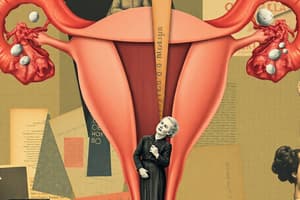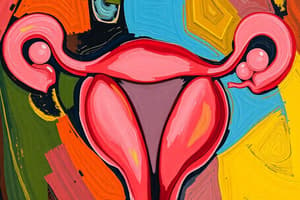Podcast
Questions and Answers
What is the evaluation method recommended for assessing ovarian issues?
What is the evaluation method recommended for assessing ovarian issues?
Transvaginal ultrasound (TVUS) or pelvic ultrasound (PUS); TV/US is best
Which characteristics categorize ovarian cysts as high risk for cancer? (Select all that apply)
Which characteristics categorize ovarian cysts as high risk for cancer? (Select all that apply)
- Thick septations (correct)
- Anechoic
- Solid (correct)
- Nodular (correct)
- Unilocular
- Fluid filled
Functional ovarian cysts typically follow a menstrual cycle.
Functional ovarian cysts typically follow a menstrual cycle.
True (A)
In cases of ovarian torsion, there is complete or partial rotation of the ovary on its ligaments and ________ supply.
In cases of ovarian torsion, there is complete or partial rotation of the ovary on its ligaments and ________ supply.
Match the benign tumors with their corresponding cell types:
Match the benign tumors with their corresponding cell types:
Study Notes
Ovarian Disorders
- Adnexa refers to the area between the lateral pelvic wall or the top of the uterus.
- Evaluate ovarian disorders using TVUS/PUS, with TV/US being the best method.
- Ovarian issues in menopause should be considered cancerous until proven otherwise.
Functional Ovarian Cysts
- Functional ovarian cysts are asymmetrical or symmetrical and follow the menstrual cycle.
- Categorize ovarian cysts as high or low risk for cancer based on characteristics:
- Low risk: anechoic, unilocular, fluid-filled
- High risk: solid, nodular, thick septations
- Biomarkers for cancer suspicion: CA125, alpha-fetoprotein, beta HCG
Management of Ovarian Cysts
- For large cysts (> 8-10 cm), perform surgical removal (Sx).
- For recurrent cysts, prescribe oral contraceptives (OCP).
- For ruptured cysts:
- Uncomplicated: observe, pain meds, rest
- Stable with hemoperitoneum: hospitalize, fluids
- Hemodynamically unstable with ongoing hemorrhaging: laparoscopy, cystectomy (preserve tissue)
Types of Ovarian Cysts
Follicular Cyst
- Cause: failed growth or rupture
- Characteristics: unilocular, smooth, thin-walled
- Symptoms: unilateral pain, asymptomatic or symptomatic if large
- Diagnosis: TVUS/PUS
- Treatment: repeat TVUS in 1-2 cycles, < 8 cm supportive, > 8 cm laparoscopy or laparotomy
Corpus Luteum Cyst
- Cause: failed degeneration
- Characteristics: slightly larger cyst with progesterone release > 14 days
- Symptoms: dull pain, secondary amenorrhea
- Diagnosis: TVUS/PUS
- Treatment: repeat TVUS in 1-2 cycles, < 8 cm supportive, > 8 cm laparoscopy or laparotomy
Corpus Hemorrhagium
- Cause: failed degeneration
- Characteristics: rapidly increasing cyst with hemorrhage
- Symptoms: acute pain in luteal phase, potential hypovolemia
- Diagnosis: TVUS/PUS, CT scan
- Treatment: repeat TVUS in 1-2 cycles, < 8 cm supportive, > 8 cm laparoscopy or laparotomy
Theca Lutin Cyst
- Cause: pregnancy, trophoblastic disease, induced ovulation with clomiphene and gonadotrophin
- Characteristics: bilateral pain
- Symptoms: bilateral pain
- Diagnosis: TVUS/PUS
- Treatment: repeat TVUS in 1-2 cycles, < 8 cm supportive, > 8 cm laparoscopy or laparotomy
Ovarian Torsion
- Definition: complete or partial rotation of the ovary on its ligaments and vascular supply, an emergency situation
- Risk factors: mobile ovarian mass > 5cm, history of torsion
- Symptoms: abrupt severe pelvic pain, radiating, diffuse or unilateral, N/V/fever, +/- palpable mass, +/- hemorrhaging
- Work-up: pelvic US with doppler, beta hCG, CBC
- Diagnosis: direct visualization of torsion
- Treatment: laparoscopy with detorsion, salpingo-oophorectomy if cannot detorsion or concern for cancer
- Prevention: OCP to suppress cysts, oophoropexy
Polycystic Ovary Syndrome (PCOS)
- Definition: endocrine disorder with unknown etiology, altered LH and FSH ratio
- Symptoms: acne, hirsutism, oligomenorrhea or amenorrhea, infertility, trunk obesity, DM2, anxiety, depression, insomnia
- Physical exam: bilateral large smooth mobile mass, acanthosis nigrans
- Work-up: CBC, CMP, TSH, A1C, lipid, prolactin, LH/FSH, testosterone, TVUS/PUS (string of pearls)
- Diagnosis: need 2 of the following - irregular menses, biochemical or clinical evidence of hyperandrogenism, polycystic (12+ cysts on each ovary, sizing 2-9 mm, enlarged ovarian volume)
- Treatment: weight loss, OCP, statins, metformin, letrozole or clomiphene +/- metformin
- Goals: symptom relief, prevent endometrial cancer, decrease DM, decrease CV, induce ovulation if wanted pregnancy
- Complications: increased risk of metabolic syndrome, DM, CVD, dyslipidemia, endometrial hyperplasia, endometrial cancer, pregnancy complications
Hyperthecosis
- Definition: severe form of PCOS with extreme levels of testosterone causing virilization
- Symptoms: balding, clit enlargement, deep voice, remodeling of limb and shoulder girdle
- Treatment: BSO, gnRH agonist
Benign Tumors
- Definition: most common type of ovarian tumor
- Types: Epithelial, Germ, Stromal
- Benign Epithelial Cell:
- Serous: high rate of cancer
- Mucinous
- Endometrioid
- Benign Germ Cell:
- Most common type: cystic teratoma, mature teratoma, dermoid cyst, dermoid
- Occurs in: reproductive years
- Characteristics: bone, hair, teeth, sebaceous glands
- Struma ovarii: functioning thyroid tissue
- Symptom: asymptomatic, unilateral adnexal mass, mobile, nontender
- Tx: Sx and serial US
- Benign Stromal Cell:
- Solid tumor from sex cord of gonad
- Types:
- Sertoli-Leydig: androgen
- Granulosa theca: estrogen
Studying That Suits You
Use AI to generate personalized quizzes and flashcards to suit your learning preferences.
Related Documents
Description
This quiz covers the evaluation and categorization of ovarian disorders, including functional ovarian cysts, and their characteristics. Learn about the importance of TVUS/PUS in diagnosis and cancer risk assessment.



